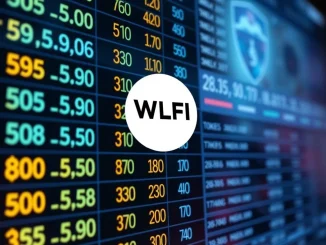
In the dynamic world of decentralized finance (DeFi), trust is the ultimate currency. As stablecoins become increasingly integral to crypto markets, the demand for clear, verifiable reserve structures has never been higher. Enter Falcon Finance, a trailblazing protocol that has just launched its groundbreaking Transparency Dashboard, setting a new benchmark for openness in the industry. This isn’t just a minor update; it’s a monumental step towards building unwavering confidence in the digital asset ecosystem, particularly concerning its synthetic stablecoin, USDf.
Unveiling the Falcon Finance Transparency Dashboard: A New Era of Trust
On July 25, 2025, Falcon Finance made headlines from Dubai, UAE, by introducing its state-of-the-art Transparency Dashboard. This innovative platform offers users and stakeholders real-time, granular visibility into the reserves that back its synthetic stablecoin, USDf. Why is this crucial? Because in an industry that has seen its share of opaque reserve structures leading to significant collapses, Falcon Finance is proactively addressing one of the most pressing concerns: solvency and accountability.
Key highlights from the dashboard include:
- Robust Over-Collateralization: The platform proudly disclosed that USDf is backed by an impressive $708 million in total reserves, resulting in a remarkable 108% over-collateralization ratio. This comfortably exceeds the essential 1:1 parity with the U.S. dollar, ensuring ample liquidity to cover USDf’s $660 million circulating supply.
- Independent Verification: The dashboard’s data has been independently verified by HT Digital, adding an extra layer of credibility to Falcon Finance’s claims.
- Detailed Reserve Breakdown: Users can explore the exact composition of the reserves, broken down by asset type, custody provider, and on-chain status. This level of detail empowers users to confirm the protocol’s solvency and operational transparency for themselves.
Understanding USDf’s Robust Collateral Structure
The strength of any stablecoin lies in the quality and diversity of its backing assets. Falcon Finance has meticulously structured USDf’s reserves to maximize resilience and minimize risk. The dashboard provides a clear picture of this diversified approach:
- Bitcoin Holdings: A significant portion, $431 million, is held in Bitcoin, leveraging the liquidity and market depth of the world’s largest cryptocurrency.
- Stablecoin Reserves: $96 million is held in other established stablecoins, providing a layer of immediate stability and liquidity.
- Diversified Assets: An additional $190 million is diversified across various altcoins and non-crypto assets, including $100,000 in tokenized U.S. Treasury bills safeguarded by Fireblocks. This broad mix helps absorb market shocks.
The majority of these reserves are held by reputable custodians such as Ceffu and Fireblocks, known for their institutional-grade security. Furthermore, on-chain holdings diversify the collateral structure, strategically minimizing exposure to centralized counterparties. The dashboard updates regularly, reflecting the latest metrics on asset composition, custodial allocations, and liquidity coverage, ensuring the data remains current and relevant.
Sustainable DeFi Yield: Earning with sUSDf
Beyond transparency, Falcon Finance offers an attractive opportunity for users to generate passive income through sUSDf, the yield-bearing version of USDf. Stakers of sUSDf currently enjoy a variable Annual Percentage Yield (APY) of 12.8%. With a current supply of 289 million sUSDf, approximately 44% of the total USDf is staked. This demonstrates a thoughtful balance between capital efficiency and robust risk management within the Falcon Finance ecosystem.
This competitive APY is designed to remain sustainable within Falcon Finance’s established risk-cap framework, balancing growth incentives with long-term stability. It represents a compelling proposition for both retail and institutional capital looking for reliable DeFi yield opportunities in a transparent environment.
Setting a New Standard for Stablecoin Trust and Accountability
Falcon Finance’s initiative aligns perfectly with broader industry trends advocating for institutional-grade transparency. In the wake of past stablecoin collapses, which were often linked to opaque reserve structures, Falcon Finance’s approach mirrors efforts by other leading protocols to adopt real-time verification tools. This proactive stance directly addresses concerns about solvency and governance in the broader DeFi landscape.
By diversifying its collateral and publishing detailed reserve data, the protocol aims to build unwavering trust amid heightened regulatory scrutiny. The 108% over-collateralization ratio is a testament to Falcon Finance’s robust risk-mitigation strategy. Unlike algorithmic stablecoins that rely solely on complex algorithms or off-chain assets, USDf’s reserves are diversified across both on-chain and fiat holdings, significantly enhancing its resilience to market volatility. This structure enables the protocol to steadfastly maintain its dollar peg while effectively absorbing liquidity shocks—a critical feature for users who prioritize stable value storage and efficient transactions.
The Future of Falcon Finance: Audits and Accessibility
To further reinforce its commitment to accountability, Falcon Finance plans to publish quarterly, independently audited reports. Users and third parties will be able to access the Transparency Dashboard directly via Falcon Finance’s official channels, ensuring continuous access to critical information. This commitment to ongoing verification and accessibility is a cornerstone of their strategy to foster long-term trust and stability.
Falcon Finance’s emphasis on both transparency and yield generation reflects the evolving demands of DeFi participants. As stablecoins become increasingly integral to crypto markets, their reserve structures and governance models face intensified scrutiny from investors and regulators. By integrating a dynamic dashboard and a risk-managed yield strategy, Falcon Finance proactively addresses these challenges, positioning itself as a leader in the next generation of decentralized finance.
Frequently Asked Questions (FAQs)
What is the Falcon Finance Transparency Dashboard?
The Falcon Finance Transparency Dashboard is a real-time platform providing detailed visibility into the reserves backing the USDf synthetic stablecoin. It shows asset composition, custody providers, and on-chain status, ensuring users can verify the protocol’s solvency.
How is USDf over-collateralized?
USDf is backed by $708 million in total reserves against a $660 million circulating supply, resulting in a 108% over-collateralization ratio. This means there are more assets backing the stablecoin than its total supply.
What is sUSDf and what APY does it offer?
sUSDf is the yield-bearing version of USDf. Users who stake sUSDf can earn a variable Annual Percentage Yield (APY) of 12.8%, balancing attractive returns with the protocol’s risk management framework.
What types of assets back USDf?
USDf’s reserves are diversified across various assets, including $431 million in Bitcoin, $96 million in other stablecoins, and $190 million in altcoins and non-crypto assets, such as tokenized U.S. Treasury bills.
Why is transparency important for stablecoins like USDf?
Transparency is crucial for stablecoins to build trust and ensure stability. By openly disclosing reserve details, Falcon Finance addresses concerns about solvency and governance, especially in light of past stablecoin collapses, and aims to meet growing regulatory scrutiny.



